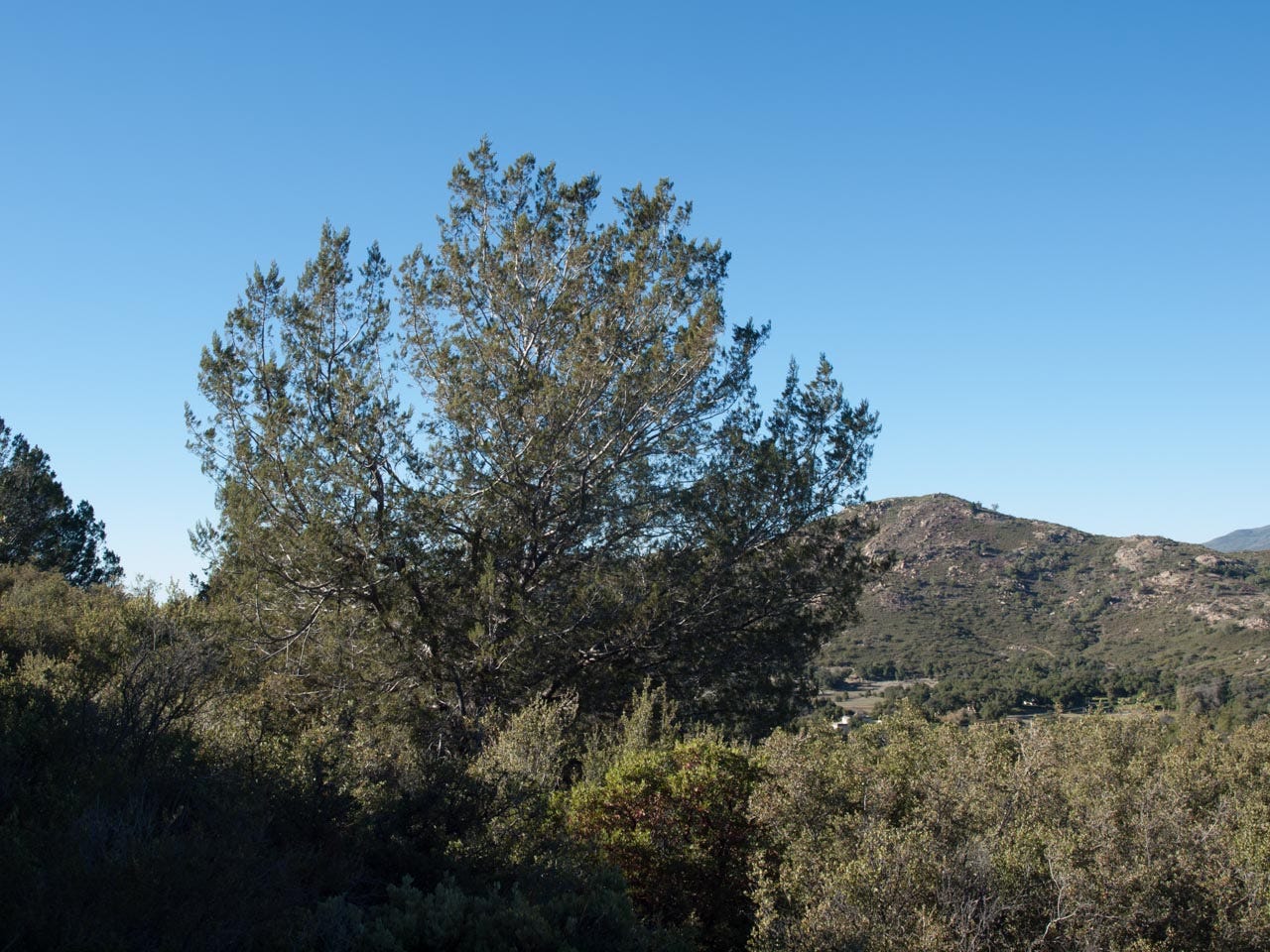Crack!
That’s a familiar sound as I saw a Tecate cypress branch. This small tree has some of the most brittle wood I’ve ever dealt with. If I’m not careful when cutting a branch from a trunk, the branch can crack, pulling a scar down the side of the trunk and potentially harming the tree. There aren’t a whole bunch of folks who have done what I’m doing now, trimming up a Tecate cypress, but I have been warned that careless pruning can weaken the tree or even kill it. That crack lets me know I need to saw a bit from the bottom of the branch to ensure that if the branch suddenly falls, the damage won’t spread to the trunk.
The wood is both brittle and hard, which makes pruning a big chore. It takes a lot of effort and a long time to cut a three- or four-inch-thick branch. But for a horticulturist like me, the hard wood can also work to my advantage. The termites that have invaded the nearby toyon tree don’t have a chance with this cypress.
Snap!
That’s the sound when I clip a smaller branch with a lopper. These smaller branches are a reddish brown. The bark of the larger branches and the trunk is smooth, dark green, with patches of dark brown. The leaves are flatish lobes that give off a Jurassic Park vibe. Indeed, the Tecate cypress is considered a relict species, which is any ancient, formerly widespread species that now survives only in small, isolated environments. This cypress hangs on in small stands in the Peninsular Range, the sometimes dramatic string of mountains that runs north-northwest from Baja, Mexico, up through San Bernardino. The tree’s natural range in these mountains is from 1,000 to 5,000 feet.
I’m working about 15 feet above sea level. This Tecate cypress was obviously planted here by someone. The tree is available at more than two dozen nurseries in California. You can probably find it at nurseries outside the state, too. I’m trimming the tree to clear branches and leaves from the enclosures that house our raptors at the small zoo I work at. Avian flu has been reported in Los Angeles, about 100 miles north of us. This flu variant is supposed to be pretty nasty. It is thought that keeping the birds’ enclosures free of greenery might keep them free of infection

.
While Calflora, a nonprofit database of California plants, indicates that Tecate cypress trees grow in five counties of southern California, the California Native Plant Society’s Calscape website shows them growing in a more limited range, from southern Los Angeles to the Mexican border. (The Tecate cypress also lives in the mountains of Baja, but I have no mapping or other information on that.)
Like other cypress, these trees give off a piney aroma when I rub against them or touch them. Maybe that’s one of the reasons I like my job so much. That smell of pine is one of the most wonderful scents in the world. I don’t know about you, but when I smell pine, particularly when I’m on a mountain trail, it is impossible to be unhappy. Christmas memories, with real Christmas trees, might have something to do with this, but it’s no matter to me now. For me, the smell of pine is right up there with the aroma of pizza fresh out of the oven.
An endangered tree
Tecate cypress have a California Native Plant Society rare plant ranking of 1B.1, which means that the plant is “rare, threatened, or endangered in California and elsewhere; seriously threatened in California.” And while the Tecate cypress has for generations been an endangered rarity, recent developments threaten the tree further.
Like the other plants of the chaparral, Tecate cypress are adapted to periodic fires. Their reproductive strategy evolved from the presence of fire in their environment. Their cones release seeds when they are heated during a wildfire. Climate change and ignition from power lines, tossed cigarettes, and other human activity are causing fires to come through their mountain habitat more frequently. The cypress are then denied the time they need to sexually mature, which for this species is from 30 to 40 years. (This problem was the topic of The Green Dispatch on October 17.) Stands of cypress burned on Otay Mountain in San Diego County in 2003 and 2007. And the northernmost stand in Orange County burned in 2006. I have been to Otay Mountain in the last few years and have seen stands of Tecate cypress that have cropped up since the 2007 wildfires. Lots of healthy new trees are growing, but any wildfire on that mountain or in the mountains of Orange County could extirpate the populations.
More complications
Making things even more complicated, the larvae of the Thorne’s hairstreak, a small, subtly colored butterfly feed only on the Tecate cypress. The only populations—five in all remaining—are found in the Otay Mountain Wilderness, a reserve encompassing Otay Mountain, just north of the U.S.—Mexico border. If the cypress are wiped out from the mountain, the butterfly faces certain extinction.
Despite this incredibly precarious existence for the Thorne’s hairstreak—an endangered species relying on an endangered species for survival—the U.S. Fish and Wildlife Service has refused for decades to list the species as Endangered.
Although the future of the Thorne’s hairstreak is doubtful, the Tecate cypress may continue, even if fires rage through southern California more and more frequently. The San Diego Zoo has initiated a conservation program, including a seed bank and a nursery for the cypress at the San Diego Zoo Safari Park. The tree may also live on as what I call a “captured cultivar,” propagated by nurseries and planted in people’s yards and gardens.
So what does the future hold for the Tecate cypress? What will happen to the butterfly that relies on the tree, the Thorne’s hairstreak? If you think you might know, please leave your thoughts after clicking the comment button.
For more environmental science & news follow me on Twitter @EcoScripsit.



